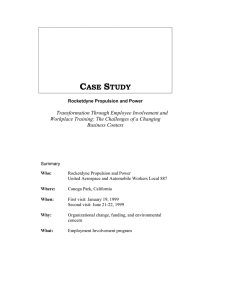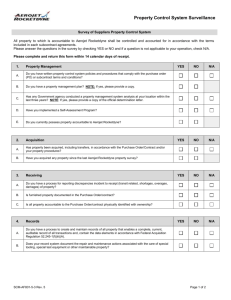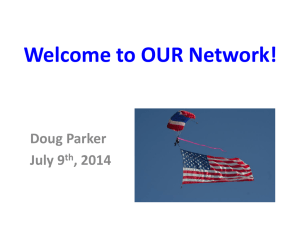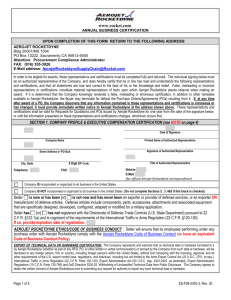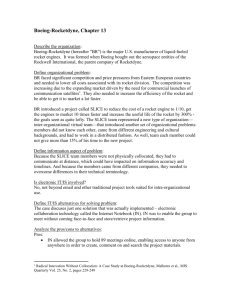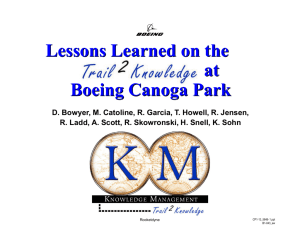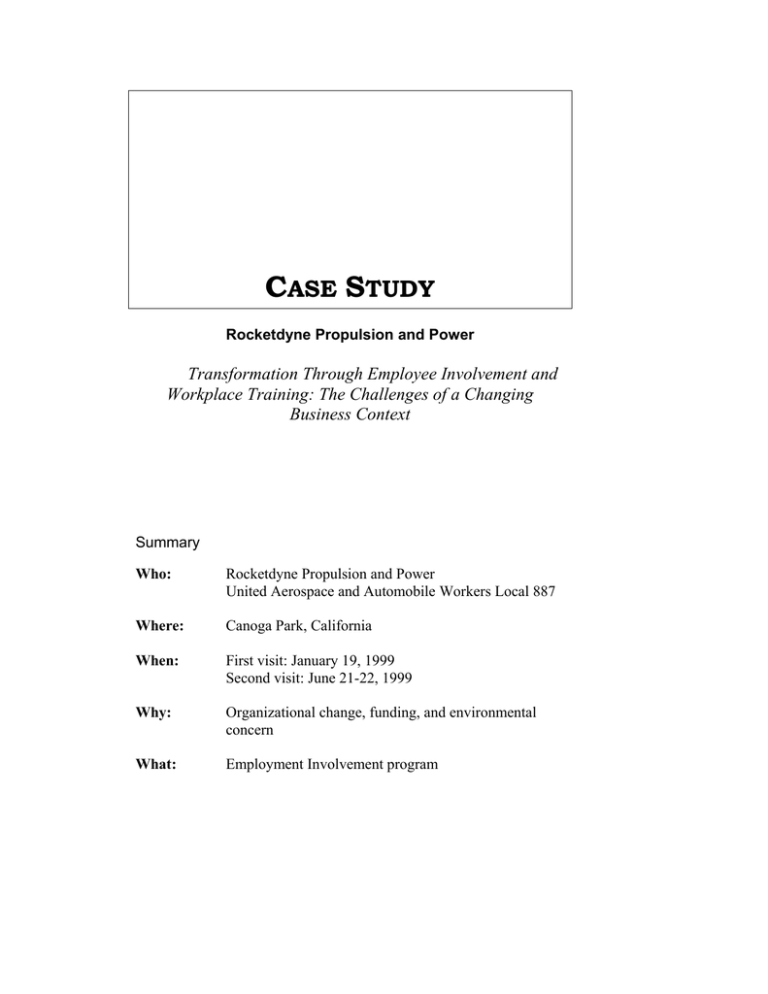
CASE STUDY
Rocketdyne Propulsion and Power
Transformation Through Employee Involvement and
Workplace Training: The Challenges of a Changing
Business Context
Summary
Who:
Rocketdyne Propulsion and Power
United Aerospace and Automobile Workers Local 887
Where:
Canoga Park, California
When:
First visit: January 19, 1999
Second visit: June 21-22, 1999
Why:
Organizational change, funding, and environmental
concern
What:
Employment Involvement program
Introduction:
Rocketdyne is a leading producer of rocket engines and related space
products facing an increasingly competitive global environment. For
Rocketdyne the challenges include a shift from a heavily military
focus to a more commercial focus, acquisition by Boeing,
environmental and pollution concerns, and developing a lean
production work organization system.
A vigorous employee
involvement program is a defining feature of the Rocketdyne story.
However there are ongoing challenges integrating front-line
innovation with line leadership and business strategy.
Company Background:
Rocketdyne was established in 1955 as a separate division of North
American Aviation, Inc. The company subsequently became part of
Rockwell International Corporation and on December 5, 1996 was
acquired by the Boeing Company.1 During its forty-one years of
operations, the company has earned a distinguished record for product
successes, including the F-1 and J-2 rocket engines for the Apollo 11
Moon Lander.
The Canoga Park facility visited for this case study is a sprawling
430,000 square feet with oversized cone-shaped annealing furnaces,
specialized cutting, grinding, and milling machines, and highly
specialized, one of a kind rocket parts.
During the current
manufacturing process, an engine makes a 22 miles journey without
ever leaving the facility—which is an additional factor driving the
process improvement effort in the organization.
Rocketdyne Canoga Park currently produces a long list of top quality,
high technology products including:
•
Space Shuttle Main Engines: The Space Shuttle uses three of
these staged combustion, reuseable liquid hydrogen fueled
rocket engines. This is the only operational, reuseable engine
designed for human space flight.
•
Space Station Electric Power Systems: Rocketdyne is
responsible for the end-to-end electric power system (EPS)
architecture for the International Space Station.
•
Linear Aerospike Engines for the X-33 Vehicle (the first space
vehicle that looks and acts like an airplane).
•
RS-68 engines: The RS-68 engine (for the Delta IV) is the first
new liquid rocket engine to be developed in the United States in
1
25 years. This is the most powerful liquid-fuel rocket engine
ever built.
•
Theater High Altitude Area Defense Systems: Rocketdyne
continues testing of the Divert and Attitude Control System for
the Theater High Altitude Area Defense (THAAD) Program.
•
Lasers and Electro-Optics Applications: Rocketdyne
continues to be a major developer of high power lasers.
Summary of Types of Instability:
Rocketdyne is in the process of transition from being primarily
military focused to being more commercially focused. The impact of
this transition is more easily understood when one recognizes that the
company was created to produce rocket engines “in support of national
defense and U. S. involvement in space.”2 This transition provides an
organizational change backdrop for the other two types of instability:
funding shifts and technology change. Further, the facility faces the
challenge of the environmental impact of the Santa Susana engine test
site that supports Canoga Park production.
The funding shifts currently exercising the most impact at Rocketdyne
are also linked to the shift of business from military to commercial.
The largest percent of Rocketdyne’s business is the space shuttle main
engines for the National Aeronautics and Space Administration
(NASA). Rocketdyne also produces Delta rockets for the U. S.
military. Currently both NASA and the U.S. Military are experiencing
budget constraints derived from reduced spending on space
exploration, the end of the Cold War, and increasing
commercialization of the international space station.
Reacting to these environmental and competitive pressures,
Rocketdyne has chosen to search for more commercial business. The
goal is to increase sales to the commercial market to 50% of total
sales. This means the company faces increasing global competition
that will drive advancing technology, cost cutting, and improved
quality. Rocketdyne’s competitors are Chinese, French, and Russian
companies. The Russians have a recognized cost advantage in the high
power rocket engine sector of the market.3
Since the 1996 Boeing purchase, Rocketdyne has experienced only
moderate organizational change. For example, the laser and electrical
optics groups are now separate organizations although they are located
within the Canoga Park site. Despite many issues surfaced by the
business press regarding the Boeing/McDonnell Douglas merger in
2
1997, Rocketdyne appears to have been somewhat insulated.
Employee Involvement and training innovations have not been
integrated with parallel efforts at Boeing -- so the change in ownership
has caused minimal day-to-day change.
Technological change has focused on the company’s strategic
processes and capabilities. When it acquired Rocketdyne, Boeing
invested large amounts of capital for equipment and machines. One
example is the $6.9 million in hardware, software, and fiber optics
acquired to develop its new Electronic Work Instructions Package
(EWIP).4 One manager told us that “business decisions are based on
technology, not price, and technology is seen or evaluated as best
value for the product.” The facility must identify and drive for a
position at the technological edge. Failure to do this in a globally
competitive market will result in the loss of new business and the
ongoing acquisition or development of new products.
A final source of instability is the potential controversy over
environmental concerns about the engine test facility. The 2,700 acre
Santa Susana engine test facility is located about a 20-minute drive
from Canoga Park among the Santa Susana hills. When the test
facility was first created, there were few people living in the area.
Now housing developments are creeping closer. People living close to
the facility are concerned about air pollution and the noise produced
by the testing. Furthermore, Rocketdyne discovered groundwater
contamination in 1984. Since then the company has cooperated with
environmental regulatory authorities and taken the corrective actions
recommended by them. Nonetheless NASA’s Office of Inspector
General reported that the estimated time to clean up groundwater
contamination at the Santa Susana test facility is 40 years.5
Summary of Mitigation Strategies:
Two key mechanisms that can help mitigate instability are found in
this site – employee involvement and workforce training. Both
represent “bottom-up” strategies.
Employee Involvement Program
Among the mitigation strategies that the facility uses to help balance
instability are the well developed employee involvement programs and
team training. A vigorous employee involvement (EI) program, started
in 1990 under the Rockwell ownership, is a key competitive strategy
for meeting the challenges of instability. Rocketdyne’s EI program
and their change process are recognized by the aerospace industry and
national media.6 This leading Employee Involvement program was
3
spotlighted at the first Lean Aerospace Initiative (LAI)7
Implementation Workshop in 1997.
A joint presentation by
Rocketdyne management and UAW Local 887 was favorably
received.
Teams are a key component of the Employee Involvement Program.
There are more than 120 Employee Involvement (EI) teams and six of
these are self-directed work teams. Self-directed team members share
the responsibility for goal setting, team performance, task/job
completion, problem solving and quality. EI team members are
involved in the hiring process and involved with the budgeting
process. Each year’s budget is decided based on last year’s budget.
Therefore, information on how they spend the budget is important for
the process. One of the team members said , “We made our own
arrangement to use a budget surplus and changed the floor setup,
cleaned up the order of the machines, and bought new chucks.”
The EI program was initially focused on employee empowerment and
teamwork at what is termed the “touch” labor level, but now salaried
employees are also forming EI teams. As employees gain experience
as team leaders they are frequently able to use these skills in filling
new management positions –leadership skills instead of technical skills
are being given an ever greater weight in being a manager. Integrated
product teams (IPT) also participate in EI, with the aim of driving
business responsibility down to the team level. The goal for the team
is to include cost savings through
“…we made our own
cycle
time
reduction,
quality
arrangement to use a budget
improvement,
safety,
and
surplus and changed the floor
accountability to goals. The EI
setup, cleaned up the order of
program goals are designed to align
the machines, and bought the
team level activity with business
new chucks.”
goals.
A joint committee that
consists
of
bargaining
unit
-EI Team Member
representatives and management
evaluates the success of the program.
The Employee Involvement program was negotiated between the
United Auto Workers union (UAW) and the company (Rockwell
International) in 1990. The focus of the negotiations was team-based
work with established joint national and local employee involvement
committees. They developed an employee involvement philosophy
(including joint partnership), and started to work on a contractual
language (finished in 1993). Their implementation strategy included
the appointment of UAW EI facilitators, established partnerships with
company facilitators (HR), and the formation of specific local joint
committees to establish and benchmark other companies. Under the EI
4
structure, UAW team leaders are selected by their peers. Team leaders
and team managers attend training together where they learn to work
as partners in managing the team.8
The EI program creates an opportunity to say, "how work is done,"
introduces more training, and more contact with management and
communication with employees. As the EI process allows workers to
change their work, issues of trust between managers and workers
become important. According to one EI member, “management starts
to believe in the workers and they start to understand the final product
of EI.”
One of the key elements of the EI program is team decision-making.
Teams are expected to take over day-to-day management of their work
area. One team member mentioned that, “EI changed things 180
degrees from the past. It is expected that the team should take over
day-to-day management. About 90% of the decision is made by the
team.” Information sharing, including information on budget is
important. Many of the employees mentioned that they were happy
about these changes, though with some caution one person said, “at
least someone listened,” and another stated “if they don’t use it, at
least we had the chance to say it.”
Training:
Employee involvement builds upon training, employee empowerment
and teamwork. A joint Rocketdyne/UAW team designed joint EI
Training. Guidelines developed by the joint team include:
•
“Require a prerequisite to becoming a team leader to get truly
interested candidates
•
Team leaders and team managers attend training together to
learn partnership and leadership skills
•
Entire team (including TL and TM) attend training together to
learn basic team skills and techniques
•
To promote a Union Company partnership, all training will
have both parties facilitating the training
•
To gain commitment for the program train floor/shop
employees to conduct the training.”
The team and team leader training include a three stage training
process:
5
•
•
•
Phase I - Team Leader Candidate Class: 16 hours of training in
2~4 hour modules. Training focused on communication skills,
leadership skills, problem-solving skills, and decision-making
skills.
Phase II - Team Leader/Team Manager Class: 20 hours of
training in 1, 2, and 4-hour modules. Team leaders and Team
Managers attend training together to learn partnership and
leadership skills.
Phase III - Team Training Class: 20 hours of training in 4-hour
modules.
Other training offered includes 80 hours of numerical control (NC)
training for each machinist but there is also training for maintenance
and for EI job combos (conflict resolution, etc).
…the attitude or
Job combos are jobs that combine duties from
culture change is
one or more previously separate sets of tasks.
also beginning to
New skills must be acquired by those who
occur because the
perform these combo jobs.
teams have been
given more
Some managers mentioned that culture is a check
responsibility and
off box after training although there is a culture
decision making
change under way. One of the value changes
capabilities
described by a manager is that “leadership skills
instead of technical skills are important to
success.” Some of the team members mentioned
that the attitude or culture change is also beginning to occur because
the teams have been given more responsibility and decision-making
capabilities.
All training is delivered jointly by facilitators from the company and
the union. The core of all training in the facility is 4000 hours of job
combo training. (where training combined 2 jobs together). The state
of California has granted a $10-14 per hour subsidy or reimbursement
for the facility when it offers this training.
Two further components of interest in the EI include coaching and
WINGS. In coaching peers stress team training and try to help people
get along and to talk in a better way, WINGS is diversification training
-- about dealing with different cultures.
6
Table
Sources of Instability:
Rocketdyne and Other Aerospace Plants
At this site and others, we conducted an attitude survey to study
peoples’ views on instability and related topics. The following table
features the results on some survey topics for this location and the
average results for all others. The survey topics are a variety of
instability types, all from three broad sources of stability; changes in
funding, changes in technology, and changes in organizational
structure. For example, funding instability is reflected in changes in
budget allocation for government contracts, internal company budgets
and, product demand. These results represent a sample of the views of
the entire workforce and must be interpreted from that perspective.
At Rocketdyne three of the instability types were significantly
different from the average scores; changes in budget allocations for
government contracts, supplier performance, and voluntary turnover.
The biggest positive difference was in the scores for changes in
external instability as seen in the changes in budgets for government
contracts. This reflects accurately Rocketdyne’s current efforts to shift
toward more commercially focused business and away from a previous
emphasis on the military/defense market. This means that a broad
cross section of the workforce is very aware of this strategic challenge.
Significant results were found in two areas of internal instability:
voluntary turnover and supplier performance. In both cases the scores
were significantly and negatively different from the overall scores.
Given the current initiative aimed at building team-based work and
increasing employee participation plus the high skill levels associated
with aerospace work, voluntary turnover would certainly have a
negative impact on performance. The facility is already facing a
shortage of skilled machinists and scores reflect concerns that were
raised about the pace of efforts underway to remedy this shortage.
People in this location also have experienced supplier performance
issues as a significant source of instability. Clearly this is a subject for
further research.
7
EXTERNAL SOURCES
OF INSTABILITY
Budget Allocations
Product Demand
Customer Requirements
Equipment/Technology
Supplier performance
INTERNAL SOURCES
OF INSTABILITY
Internal budgets
Voluntary turnover
Reengineering
Leadership vision
Tension/stress around
change
Subcontracting out work
In sourcing work
ROCKETDYNE n=66
(1=never, 2=sometimes,
3=frequently)
AVERAGE OF
OTHER PLANTS
(4 plants, n=408)
DIFFERENCE
1.95
2.05
2.26
1.92
1.59
1.65
2.25
2.26
2.16
2.00
0.31 **
-0.20 **
0.00
-0.23 **
-0.40 ***
2.06
1.67
1.92
2.09
2.14
2.12
1.98
2.05
2.15
2.14
-0.06
-0.31 ***
-0.12
-0.06
0.00
1.82
1.47
1.72
1.53
0.10
-0.06
* .1 level of statistical significance; ** .05 level of statistical significance; *** .01 level of statistical significance
Challenges
For many years the Rocketdyne facility operated in a relatively stable
organizational and funding environment, but that has changed. Today,
the Defense Department wants to increase the private sector's
involvement in military space programs.9 The EI program is helping to
mitigate this shift with the organizational transition but there are some
mismatches and conflicts that still exist between managers, engineers,
and machinists or touch labor.
The EI program is moving into the workplace well but still has barriers
to overcome. It is necessary to make sure that all the team members
are trained, not only hourly workers but also engineers and upper
management. As one union official noted, “ The contract says that we
will do our part, and the membership has done their part, …upper
management is not doing their part.” The intention of employment
involvement is to increase the participation of teams out on the shop
floor. Team members learn to control budget, work area issues, and
work processes but some managers are unwilling or unable to give up
control, so some teams do not have the same level of input.
8
Ongoing change and the EI program are driving adaptations in the
organizational culture. This is also not an easy process. For example,
one machinist recounted a story about an incident with the titanium
parts wash process. The wash procedure involves dipping a part in a
chemical bath that reacts with the metal of the part. A machinist was
rotated to the job without completing training. An error occurred
when an expensive part was dipped into a chemical bath that caused
corrosive damage to the part. The normal procedure when this type of
error occurs is outlined in Rule 48 which specifies that if a machinist
makes a mistake, he/she is to be written up for the mistake, and must
be taken out of that job. As might be imagined, this rule creates little
incentive to report mistakes even when they might later cause further
problems. Management’s attitude in the past has been that mistakes
need to be punished. This attitude must shift to one that encourages
employees to learn from mistakes and make corrections as needed.
Workplace learning and participation often depend on how the parties
react to failures as well as successes.
One of the managers said that the change is difficult in a system with
40 years of history in traditional authoritarian relationships.
Management still struggles with a mentality that says, “we pay the
money and we make the decisions.” There is often conflict between
new commercially oriented attitudes and older military minded
attitudes. Traditional roles as well as traditional attitudes must change.
For example, under the new work environment, performance is
dependant on the strength of EI team leaders and managers. They
must understand that their role is different from the traditional role.
Flexibility also must be part of the machinist’s role. For example,
under the EI program, the machinist’s job may now include
inspection.10 Machinists are also beginning to do some simple
maintenance, i.e. changing lights, monitoring lubrication levels, and
reducing the amount of certain types of work that regular maintenance
workers perform. These changes of jobs and roles can cause conflict
between machinists, maintenance workers, and engineers especially
when these separations have long been governed by hard won contract
language.
The job sharing and rotation efforts are driven by the fact that
Rocketdyne and the entire industry are facing a shortage of machinists.
Not enough skilled machinists are available nor are there young
trainees in apprenticeship or other training programs. The youngest
machinist at Rocketdyne is 39. In fact, one of the machinists said to us
“I’m young,” and he is 43 years old.
9
One union official expressed his concern that the company views are
short term and the management team has not yet discovered how
serious the situation really is. A union survey shows that only one area
high school teaches machining. A successful effort was made to help
the high school acquire updated tools for trades training. The Brown
and Sharp Tool Company offered to install machines in the facility to
allow on-site training in exchange for access by the machine company.
The company said “no.” Many employees at Rocketdyne are in their
50’s and 60’s, while only a few new hires are in their 20’s and 30’s.
The union’s concerns for future jobs and skills development do not
mesh well with the more short term concerns and profit oriented
management activities. One of the union members said that “the
managers are not thinking ahead – not enough machinists, not enough
skills, and these skills are not being taught in our schools or factories,
it’s a dying skill."
Conclusion
Students in the public schools are not learning the skills needed to fill
the vacant positions at the Rocketdyne and experienced employees are
retiring from the company taking their knowledge and skills out the
door when they leave. While the Rocketdyne focus on EI’s process
skills such as communication and problem-solving abilities is
important, there is less stress on work-based skills. An old mentality is
still present which as one person puts it, “we lay people off when the
work slows down and we don’t need to worry since other places will
provide training for people that we can hire when the work picks up.”
Machinists have to operate specialized machines that require unique
skills and experiences. If the company continues its current
employment practices, they will soon lose the experienced workers
with necessary work-based skills. A SWOT (current strength, current
weakness, future opportunity, and future threats) analysis done among
groups of workers at the plant show their concerns for this trend. The
number one current strength was "the ability of the work force (core
competencies, specialized knowledge)” but their number one weakness
was "no accountability (accountability is not across the board)."
There is a gap about content of work between management and skilled
workers. This reflects a gap between instability and mitigating
strategies. The EI program at Rocketdyne has survived the acquisition
by Boeing. It is still a very active program, but recognition of EI
activity is limited at the plant level. Continuation of the EI program
will contribute to a smooth transition from Rockwell International to
Boeing, as well as helping to meet the challenges of a shift from
military focus to commercial focus and international competition. The
10
program will have a greater impact with increased links to business
strategy.
Effective functioning of the EI program is necessary to align team
level activity with aggregate business goals. In order to improve this
process, improving communication skills, information sharing
amongst teams and an attitude change of the managers and team
members is important, but also the EI program has to stress that its
bringing market (internal and external customer) information into the
EI process. Rocketdyne is now faced with organizational and cultural
change issues of technologies and market competition. If the EI
program is intended to bring customer needs into the process, then the
program should be evaluated by judging the level of the customer
satisfaction. This will bring market pressure into the system and this
pressure will influence the employee’s attitude/morale and the culture
of organization.
11
Endnotes
1
From Boeing Backgrounder information sheet available at www.boeingmedia.com
2
From Boeing Backgrounder information sheet available at www.boeingmedia.com
3
Ashley, S. (1998). Bringing launch costs down to earth. Mechanical Engineering,
120 (10), Fortune, November 8, 1999, The Economist (1999) Asia: A divine lift-off
for China, Nov 27.
4
Chase, N. (1998). Paperless manufacturing pays off. Quality, 37 (11), 46-47.
5
IG-98-024, Cost Sharing for Santa Susana Field Laboratory Cleanup Activities.
NASA, Washington DC.
6
Fortune, November 8, 1999.
7
The Lean Aerospace Initiative (LAI) was formally launched in 1993 and has
evolved over time. LAI is a research partnership among the U.S. Air Force, labor
unions, aerospace industry, and the Massachusetts Institute of Technology (MIT).
8
RD and UAW Employee Involvement Program outline presented Feb. 1998.
9
Willingham, S. (1999). Pentagon space program woos suppliers. National Defense
84 (553).
10
Machinist jobs went to milling or general machinists, pdm (higher grade of 17) at
Palmdale they created general machinist and they can pretty much run each thing.
12
Teaching Notes
It is people who are the heart of new work systems – establishing
stability and then driving continuous improvement. The Labor
Aerospace Research Agenda (LARA) at MIT is committed to furthering
our understanding of the human and institutional aspects of these new
work systems, especially as they relate to broader issues of
employment and vitality in the aerospace industry. Toward this end,
LARA is pleased to announce a new series of case studies. These case
studies were written by a MIT-based research team and were
developed in conjunction with representatives from each of the sites,
with the help of representatives of the United Auto Workers and the
International Association of Machinists.
These case studies are designed for use by union leaders, managers,
trainers, college and university educators, and others interested in
fostering constructive dialogue about the current dilemmas,
challenges, and innovations in and around employment matters in the
aerospace industry. These cases can be used in a classroom setting, in
small discussion groups, or by individuals as thought starters.
This case study was prepared as an example of the challenges of
instability in the aerospace industry. It was written as a basis for
dialogue and learning, not as an illustration of either effective or
ineffective actions. There may be many possible answers to these
questions. They are designed to foster constructive dialogue and
action on these very challenging issues.
Potential Discussion Questions
The following questions may serve as a starting point for further
discussion.
•
What do you see as the strengths and limitations of
Rocketdyne’s approach to training and skills development –
with its focus on employee involvement and teams as the core
of the process?
•
What are the implications of workers getting some of their
training from outside educational providers and of workers
getting training when they are laid off?
13
•
Is there evidence of a sense of urgency around an industry
skills shortage? What would need to take place for there to be a
higher level of intensity around training?
•
For continual success the case study suggests that the EI
program needs to be linked to business strategy. How can this
be accomplished?
•
What are the consequences of salaried employees gaining
experience as team leaders and moving into management
positions?
•
Are leadership skills being valued more than technical skills
and what does this mean to the company and it’s
competitiveness?
•
Do you think that Rule-48 is a barrier to learning? If so, what
do you recommend as an alternative?
Takashi Inaba and Betty Jo Barrett prepared this case with editorial and design input
from Susan Cass, John Verbos and other members of the LARA team. This case
study is an example of the challenges of instability in the aerospace industry and was
written as a basis for dialogue and learning – not as an illustration of either effective
or ineffective actions.
Copyright © 2001 Labor Aerospace Research Agenda, Massachusetts Institute of
Technology. All rights reserved. To order copies of this case study, or to obtain a
listing of LARA case studies, or request permission to reproduce materials, please
email laraproject@mit.edu, write to the Labor Aerospace Research Agenda, Center for
Technology, Policy, and Industrial Development, MIT, 1 Amherst Street,
Cambridge, MA 02139 or call (617) 258-7207. Version 5.0
14

